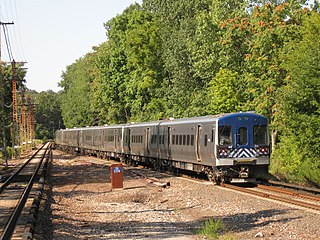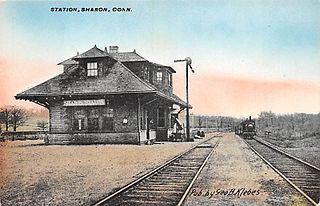
The New York Central Railroad was a railroad primarily operating in the Great Lakes and Mid-Atlantic regions of the United States. The railroad primarily connected greater New York and Boston in the east with Chicago and St. Louis in the Midwest, along with the intermediate cities of Albany, Buffalo, Cleveland, Cincinnati, Detroit, and Syracuse. New York Central was headquartered in New York City's New York Central Building, adjacent to its largest station, Grand Central Terminal.

The Empire Service is an Inter-city rail service operated by Amtrak within the state of New York in the United States. The brand name originated with the New York Central Railroad in 1967. Trains on the line provide frequent daily service along the 460-mile (740 km) Empire Corridor between New York City and Niagara Falls via Albany, the state capital.

Pawling station is a commuter rail stop on the Metro-North Railroad's Harlem Line, located in Pawling, New York. Trains leave for New York City every two hours, and about every 30 minutes during rush hour. It is 63.8 miles (102.7 km) from Grand Central Terminal and travel time to Grand Central is approximately one hour, 48 minutes.

Brewster station is a commuter rail stop on the Metro-North Railroad's Harlem Line, located in Brewster, New York. It is the southernmost station in Putnam County. Trains leave for New York City every hour, and about every 25 minutes during rush hour. It is 52 miles from Grand Central Terminal and travel time there is approximately one hour, 22 minutes.

The Boston and Albany Railroad was a railroad connecting Boston, Massachusetts to Albany, New York, later becoming part of the New York Central Railroad system, Conrail, and CSX Transportation. The line is currently used by CSX for freight. Passenger service is provided on the line by Amtrak, as part of their Lake Shore Limited service, and by the MBTA Commuter Rail system, which owns the section east of Worcester and operates it as its Framingham/Worcester Line.

The Metro-North Railroad Harlem Line, originally chartered as the New York and Harlem Railroad, is an 82-mile (132 km) commuter rail line running north from New York City to Wassaic, in eastern Dutchess County. The lower 53 miles (85 km) from Grand Central Terminal to Southeast, in Putnam County, is electrified with a third rail and has at least two tracks. The section north of Southeast is a non-electrified single-track line served by diesel locomotives. The diesel trains usually run as a shuttle on the northern end of the line, except for rush-hour express trains in the peak direction and one train in each direction on weekends.

The Capitol Limited was an American passenger train run by the Baltimore and Ohio Railroad, originally between New York City and Grand Central Station in Chicago, Illinois, via Union Station, Washington, D.C., Baltimore and Pittsburgh. For almost 48 years, it was the B&O's flagship passenger train, noted for personalized service and innovation. At the time of its discontinuation on May 1, 1971, when Amtrak took over most rail passenger service in the U.S., the Capitol Limited operated between Washington and Chicago.

The Joseph Scelsi Intermodal Transportation Center is a transit facility located in downtown Pittsfield, Massachusetts. The $11 million facility is named after Joseph Scelsi, a longtime State Representative who represented Pittsfield. Owned by the Berkshire Regional Transit Authority (BRTA), it is serviced by local BRTA bus services, Amtrak intercity rail service, and Peter Pan intercity bus service. The second floor of the building houses two classrooms used by Berkshire Community College and Massachusetts College of Liberal Arts.

The Mohawk and Malone Railway was a railroad that ran from the New York Central Railroad's main line at Herkimer north to Malone, crossing the northern Adirondacks at Tupper Lake Junction, just north of Tupper Lake. The road's founder, Dr. William Seward Webb, was president of the Wagner Palace Car Company and a Vanderbilt in-law. He began by purchasing the 3 ft narrow gauge Herkimer, Newport and Poland Railway, which ran 16 miles (26 km) from Herkimer to Poland, converting its trackage to 4 ft 8+1⁄2 instandard gauge, and straightening it to avoid multiple crossings of the West Canada Creek. He then had track built from Tupper Lake to Moira and thence to Malone. A separate company, the St. Lawrence and Adirondack Railway, completed the line to Montreal, Quebec.

Adams is a former train station at 10 Pleasant Street in Adams, Massachusetts. Built in 1899, it served as the town's principal rail station on the North Adams Branch of the Boston and Albany Railroad until the mid-20th century. The surviving buildings were listed on the National Register of Historic Places in 1982 as the Pittsfield & North Adams Passenger Station and Baggage & Express House. The former station is currently the home of a sports bar and restaurant.

The Millerton station is a former New York Central Railroad (NYC) station on the NYC's Harlem Division that served the residents of Millerton, New York.

The Sharon station was one of two former New York Central Railroad (NYC) stations that served the residents of Amenia, New York via the Harlem Line.
The Hillsdale station was a former New York Central Railroad Harlem Division station that served the residents of Hillsdale, New York.
The New York, Philadelphia and Norfolk Railroad was a railroad line that ran down the spine of the Delmarva Peninsula from Wilmington, Delaware to Cape Charles, Virginia and then by ferry to Norfolk, Virginia. It became part of the Pennsylvania Railroad system.

The Kansas City–Florida Special was a pooled night train and the premier train of the Frisco Railroad and the Southern Railway. Operating from Kansas City, Missouri to Jacksonville, Florida, it was unique as being one of very few long distance passenger train to traverse the Mississippi River south of St. Louis, Missouri and north of New Orleans, Louisiana.
The Berkshire was a New York, New Haven and Hartford Railroad named train running from New York City's Grand Central Terminal to Pittsfield, Massachusetts. It was the longest-running north–south train in Litchfield Hills of western Connecticut and the Berkshires of Massachusetts. From New York City it followed the New Haven Line to South Norwalk, the Danbury Line to Danbury and the Berkshire Division to Pittsfield. It began in the 1940s and ran until 1968. The train was preceded by the Berkshire Express, of c.1938-c.1943. It terminated at Pittsfield Union Station until 1960, when the New Haven moved it to another station in the city.
The Del-Mar-Va Express was a named passenger train of the Pennsylvania Railroad that at its peak went from New York City to the southernmost point of the Delmarva Peninsula, Cape Charles, Virginia. Initiated in 1926, the train's north–south passage through Delaware stood in contrast with the main passenger traffic through Delaware being a brief passage through cities in the upper reach of Delaware, mainly Wilmington. Most importantly, the train served as a more direct path from New York City and Philadelphia to Norfolk, Virginia, by way of a ferry from Cape Charles across the Chesapeake Bay to Norfolk, a path that bypassed Baltimore and Washington, D.C. This saved time in comparison to travel over PRR, Atlantic Coast Line and Norfolk & Western trains through Washington to Norfolk. The Del-Mar-Va trip, including ferry travel was 11 hours from New York; and the longer all-land route through Washington was 13 hours and 40 minutes.
The Buffalo Day Express was a long-distance north–south Pennsylvania Railroad passenger train from Washington, D.C. to Buffalo, New York. It had a second branch that originated in Philadelphia, Pennsylvania, and at times, from New York, New York. In the southbound direction, the train ran by the name, Washington Express. It was the longest running of trains on the Washington-Buffalo route, north through central Pennsylvania on the Buffalo Line, operating from 1900 to the latter years of the 1960s, with a shortened segment until 1971.
The North Star was a named night train, train #21, 1947–1962, of the New York Central Railroad (NYC) that went from Grand Central Terminal of New York City to Union Terminal of Cleveland, Ohio. It was distinctive in the history of the New York Central's history of service to the North Country of New York State, because it was the longest lasting train in the NYC's later decades that hosted sleeping cars that went continuous from New York City to Lake Placid in the Adirondacks. Predecessor trains in the pre-World War II period carrying direct sleeping cars to the Adirondacks included the Niagara (#29) and the Ontarian.
The Canadian and later, Canadian-Niagara, was the longest running named international train from Chicago to Upper Canada via Detroit, for its first two decades running to Montreal. This overnight train was operated by the Michigan Central Railroad from Chicago to Detroit, and in a pool arrangement, it operated over Canadian Pacific Railway tracks and used the same train number from Detroit eastward. The train would carry a second section, bound, variously for Buffalo or New York City via Buffalo.












